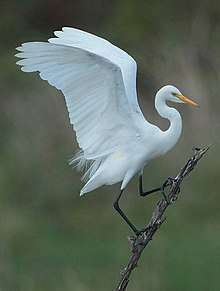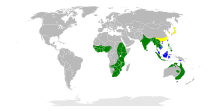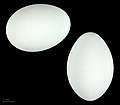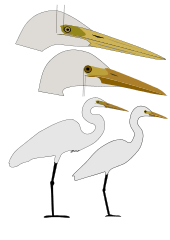Intermediate egret
The intermediate egret, median egret, smaller egret, or yellow-billed egret (Ardea intermedia) is a medium-sized heron. Some taxonomists put the species in the genus Egretta or Mesophoyx. It is a resident breeder from east Africa across the Indian subcontinent to Southeast Asia and Australia.
| Intermediate egret | |
|---|---|
 | |
| Yellow-billed egret (A. i. brachyrhyncha) in South Africa | |
| Scientific classification | |
| Kingdom: | Animalia |
| Phylum: | Chordata |
| Class: | Aves |
| Order: | Pelecaniformes |
| Family: | Ardeidae |
| Genus: | Ardea |
| Species: | A. intermedia |
| Binomial name | |
| Ardea intermedia Wagler, 1827 | |
 | |
| Breeding range Year-round range Wintering range Present during migration | |
| Synonyms | |
| |
Taxonomy
Some authorities classify the intermediate egret in its own monotypic genus, Mesophoyx, while others place it with the smaller egrets in Egretta.[2]
There are three recognised subspecies,[2][1] and these are sometimes raised in to species:[3]
- A. i. brachyrhyncha Brehm, 1854 "yellow-billed egret" - sub-Saharan Africa
- A.i. intermedia Wagler, 1827 "intermediate egret" - Asia from the Russian Far East to Japan to India and the Greater Sundas
- A. i. plumifera Gould, 1848 "plumed egret" - eastern Indonesia, New Guinea and Australia.
A.i. intermedia differs from A.i. brachyrhyncha and A. i. plumifera by having a black bill when in breeding plumage, while A.i. plumata has a yellow-and-pink bill and A. i. brachyrhyncha has much yellower lores and face. A further difference between the nominate subspecies and the "yellow-billed" subspecies are that the "intermediate" subspecies has black at the top of the legs compared to reddish in the yellow-billed egret.[3]
 Intermediate Egret (A.i. intermedia), Mysore, India
Intermediate Egret (A.i. intermedia), Mysore, India Plumed Egret (A.i. plumata) in breeding plumage, Fogg Dam Conservation Reserve, Northern Territory, Australia
Plumed Egret (A.i. plumata) in breeding plumage, Fogg Dam Conservation Reserve, Northern Territory, Australia Ardea intermedia brachyrhyncha - MHNT
Ardea intermedia brachyrhyncha - MHNT
Description
This species, as its scientific name implies, is intermediate in size between the great egret and smaller white egrets like the little egret and cattle egret, though nearer to little than great. It is about 56–72 cm (22–28 in) long with a 105–115 cm (41–45 in) wingspan and weighs c. 400 g (14 oz),[4] with all-white plumage, generally dark legs and a thickish yellow bill. Breeding birds may have a reddish or black bill, greenish yellow gape skin, loose filamentous plumes on their breast and back, and dull yellow or pink on their upper legs (regional variations). The sexes are similar.[5]
Differences from great egret

The non-breeding colours are similar, but the intermediate is smaller, with neck length a little less than body length, a slightly domed head, and a shorter, thicker bill. The great egret has a noticeable kink near the middle of its neck, and the top of its longer bill nearly aligns with the flat top of its head. Close up, great egret's gape line extends behind the eye, while the intermediate's is less pointed and ends below the eye. The intermediate tends to stalk upright with neck extended forward. The great is more patient, often adopting a sideways-leaning "one-eyed" stance.
Differences from little egret
Little egrets have yellow-soled feet and black bills. They often run after fish in shallow water. Breeding birds have long nuptial plumes on the back of their heads.
Behaviour
The intermediate egret stalks its prey methodically in shallow coastal or fresh water, including flooded fields. It eats fish, frogs, crustaceans and insects. It often nests in colonies with other herons, usually on platforms of sticks in trees or shrubs. Two to five eggs are laid, the clutch size varying with region.
Gallery
- Egret showing its tongue
 Photo showing the size difference in great, intermediate and little egrets, India
Photo showing the size difference in great, intermediate and little egrets, India In Northern Territory, Australia
In Northern Territory, Australia
References
- BirdLife International (2016). "Ardea intermedia". IUCN Red List of Threatened Species. 2016: e.T22727668A95229595. doi:10.2305/IUCN.UK.2016-3.RLTS.T22727668A95229595.en.
- "Storks, ibis, herons". IOC World Bird List version 8.2. International Ornithological Congress. Retrieved 25 December 2018.
- Martínez-Vilalta, A.; Motis, A.; Kirwan, G.M. (2018). del Hoyo, J.; Elliott, A.; Sargatal, J.; Christie, D.A.; de Juana, E. (eds.). "Intermediate Egret (Ardea intermedia)". Handbook of the Birds of the World Alive. Lynx Edicions, Barcelona. Retrieved 25 December 2018.
- del Hoyo, J., Elliott, A. and Sargatal, J. (1992). Handbook of the Birds of the World. Volume 1: Ostrich to Ducks. Lynx Edicions, Barcelona.
- Ali, S. (1993). The Book of Indian Birds (11 revised ed.). Bombay: Bombay Natural History Society/Oxford University Press. ISBN 978-0195621679.
Other references
- Birds of The Gambia by Barlow, Wacher and Disley, ISBN 1-873403-32-1
- Birds of India by Grimmett, Inskipp and Inskipp, ISBN 0-691-04910-6
External links
| Wikimedia Commons has media related to Ardea intermedia. |
| Wikispecies has information related to Mesophoyx intermedia |
